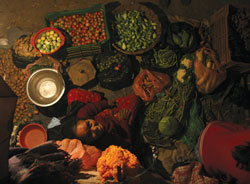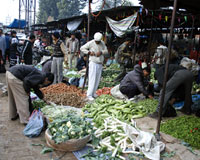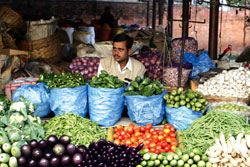|
|
They come from all sorts of backgrounds. But once here, they share the same mission, to look their freshest best and be sold to the highest bidder. Some are organic, some are not, some are seasonal while others, are, well, a little past their prime. Kathmandu's vegetable markets are a delight.
The fresh, sharp smell of vegetables and fruits, and the bustle and banter between shoppers and sellers is unmistakable. Colourful veggies are stacked row after row, in all shapes and sizes, from all over Nepal and abroad. There are lemons from Lucknow, tomatoes from Chautara, ginger from Hetauda, juicy green spinach from Bhaktapur, pumpkins from Pharping and much, much more.
Vegetable markets across the Valley are booming, driven by Kathmandu's growing population and greater awareness of the importance of fresh fruits and veggies in one's diet. Kalimati, once the king of vegetable markets, has now given way to mandis all over the city.
 In the wee hours of the morning, vegetables arrive by the truckload from all over the countryside and are picked up by wholesale vendors. The vendors in turn take their goods to smaller markets across town like in Naxal's Naryanchaur or Ason or Chabahil's well-organised tarkari bajar.
In the wee hours of the morning, vegetables arrive by the truckload from all over the countryside and are picked up by wholesale vendors. The vendors in turn take their goods to smaller markets across town like in Naxal's Naryanchaur or Ason or Chabahil's well-organised tarkari bajar.
Some like Anita and Chandra Bahadur Lama who sell their veggies in the wholesale evening market next to Birendra International Convention Centre in Naya Baneswor go all the way to Banepa at four in the morning to bring in their day's goods-sweet potatoes, ginger, garlic, green chilly. For Rs 65 a day the Lamas get a tiny space in the shed to sell their goods.
 Competition is tough, as there are plenty of choices, and the market is swarming with bargain-hunters. "Its cheaper here than in other places," says one shopper hunting for sweet potatoes for Ekadasi.
Competition is tough, as there are plenty of choices, and the market is swarming with bargain-hunters. "Its cheaper here than in other places," says one shopper hunting for sweet potatoes for Ekadasi.
With the ceasefire in place, farmers from as far off as Charikot can send their produce to Kathmandu, where supply barely keeps up with demand. Festive seasons are always bonanza time, but a healthy diet of dal-bhat-tarkari-saag ensures that business is always decent.
Vendors who want to be competitive must begin their day at the crack of dawn. Sarita Maharjan, who sells in Khasibajar, must make it to Kalimati by 4AM. Her daily shopping list varies, as she keeps a sharp eye on what her clients say their families are in the mood for. Vendors like Maharjan earn anywhere between Rs 1,500-2,000 a day.
 Some vegetables and fruits are dropped off straight to the bajars by farmers' groups. At this time of year, when the sun is up and warm at 7AM, most of the good veggies are already taken. The markets operate for two or three hours each in the mornings and evenings. During the day they are virtually deserted. Canny shoppers make sure they go towards the end of the selling day, to get better prices.
Some vegetables and fruits are dropped off straight to the bajars by farmers' groups. At this time of year, when the sun is up and warm at 7AM, most of the good veggies are already taken. The markets operate for two or three hours each in the mornings and evenings. During the day they are virtually deserted. Canny shoppers make sure they go towards the end of the selling day, to get better prices.
As the markets grow, though, so do the problems associated with them. Waste management is the biggest problem-the rubbish generated from markets like Khasibajaar is thrown into the Tukucha river that flows next to it. In other places, its just left by the side of the street until a municipality truck rolls around, by which time the stench of decomposing vegetables is usually impossible.



